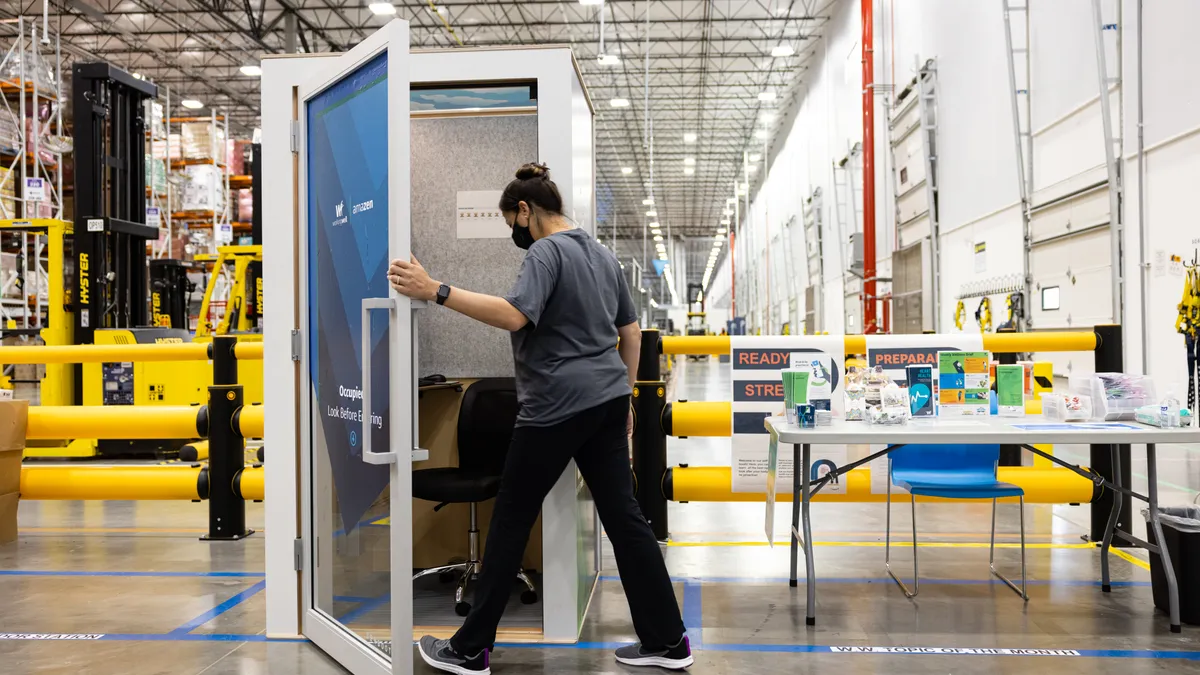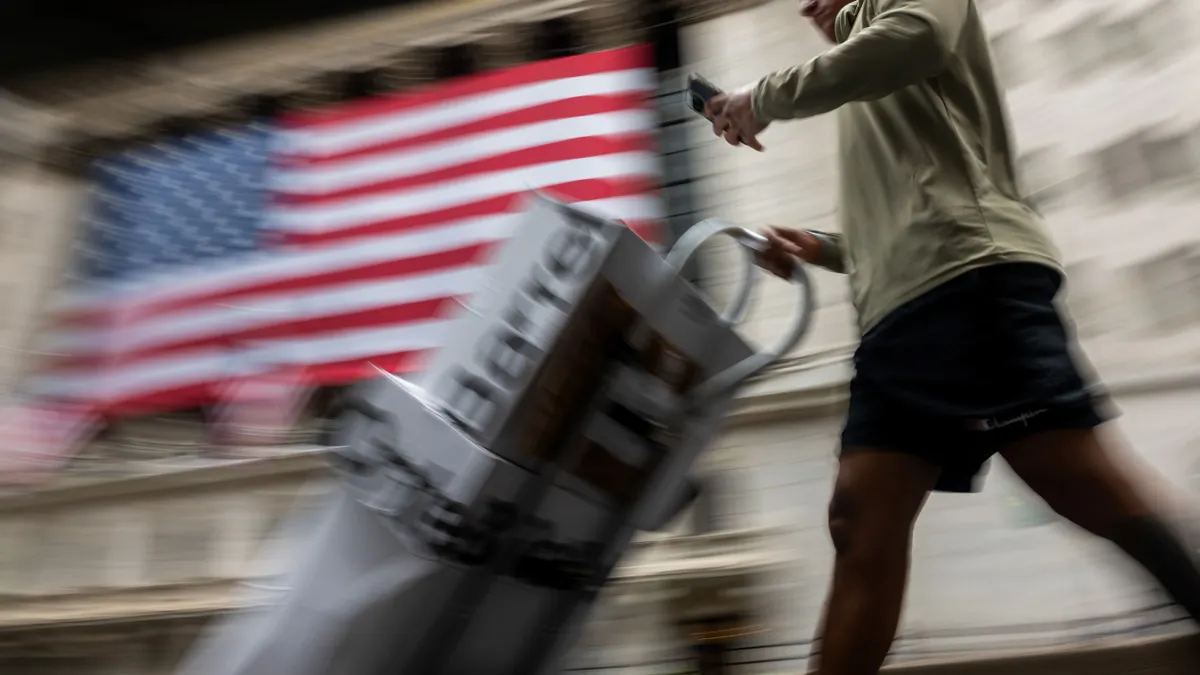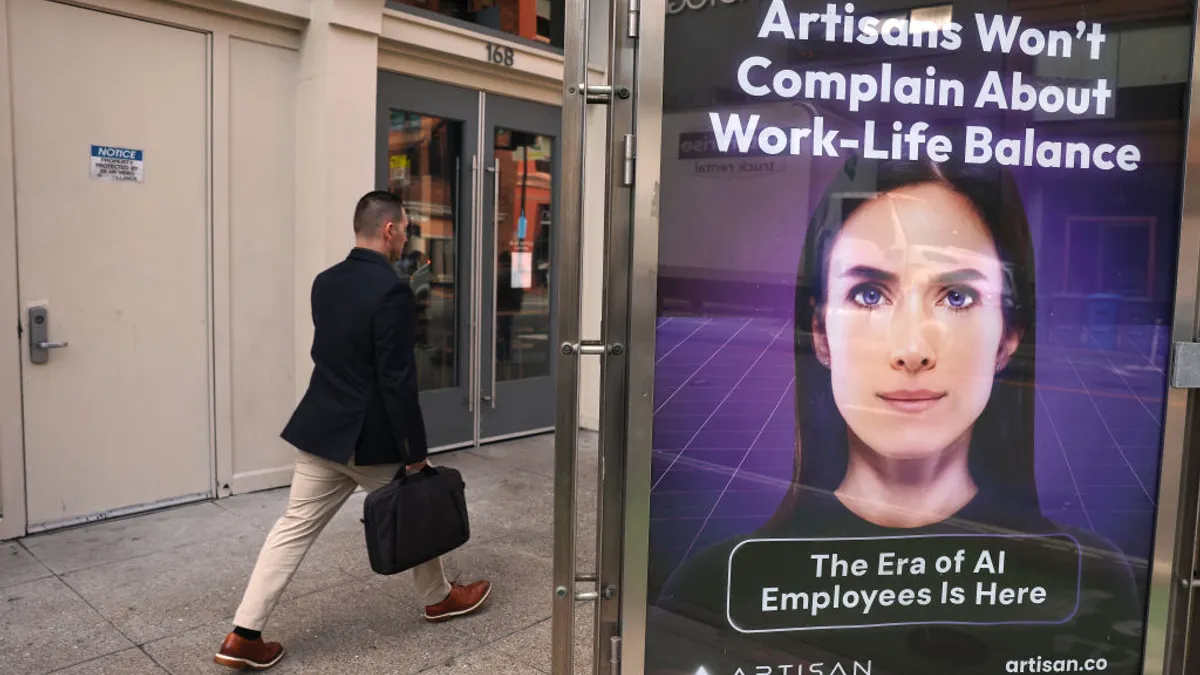It looked like a walk-in storage closet. Others compared it to a phone booth, or a portable toilet.
The subject of a Twitter video posted May 27 by Amazon was actually an "AmaZen" station, one of an unknown number of "individual interactive kiosks" being introduced to Amazon facilities.
"With AmaZen, I wanted to provide a place that's quiet that people could go and focus on their mental and emotional well-being," said Leila Brown, workplace health and safety manager at Amazon, whose voiceover accompanies the since-deleted footage of the concept. The camera shifts to a view of AmaZen's interior, decorated with greenery, posters and a small desktop computer setup.
The units are part of WorkingWell, a "comprehensive program" announced last month by Amazon aimed at improving employee health and safety as well as reducing injury risk, according to a company blog post. Brown used her background in sports medicine to create AmaZen, Amazon said.
The concept began as a pilot program in "on-site clinic spaces" and was later moved to the company's production floor. The e-commerce giant said employees can use the kiosks to watch videos that facilitate "guided meditations, positive affirmations and calming scenes with sounds."
None of these details saved AmaZen from internet ridicule. The Guardian uncovered social media posts describing it as a "Despair Closet." New York Magazine opined that "Even a Dystopia Would Wince" at it.
Those reactions occurred amid continued criticism of Amazon's employment policies. During the run-up to a recent union election at an Amazon fulfillment center in Alabama, The Guardian spoke to employees of the facility who complained of a lack of breaks and the "relentless pace" of work. In September 2020, a report by the outlet Reveal discussed injury rates at fulfillment centers and presented data showing that such injuries increased during weeks of high demand.
Amazon's fulfillment centers are known for their production quotas and fast pace of work, according to Lamar Pierce, professor of organization and strategy at Washington University in St. Louis' Olin Business School. Managers who operate at these facilities have incentives that are "almost always" geared toward "keeping your people working and moving," he noted.
Such fast-paced work, conducted in an environment where employees' time is closely monitored, can create even more stress, said Darren Good, assistant professor of applied behavioral science at Pepperdine University's Graziadio Business School. It's unclear, he added, whether AmaZen will address underlying issues present in the day-to-day design of work that impact workers' mental health.
"My first reaction is, that's creative," Good said of AmaZen. "It's certainly different. But then it felt to me like a Band-Aid approach."
A short break for meditation or mindfulness may have some benefit to employees' mental health, though the question of how effective AmaZen will be in this regard is really a medical question, Pierce said; "I think that's a medical question, but from how they phrased it, it doesn't look like they're approaching it as a medical question."
Alternatively, employers seeking to address mental health issues in their workforces might involve medical professionals, Pierce said, such as a combination of clinical psychologists, professional counselors and, potentially, psychiatrists. "If you're not a psychologist, psychiatrist or other mental healthcare professional, you'd better be careful about how you evaluate improvements to mental health," he added.
Asked whether Brown cited any academic studies or research in developing and pitching AmaZen to Amazon executives, Amazon declined to comment in an email to HR Dive, but did say the WorkingWell program and its components were developed using "scientifically proven physical and mental activities, wellness exercises, and healthy eating support."
Other potential issues concern whether Amazon employees will feel that they are able — or comfortable — to take advantage of AmaZen, given the pace of work required of them. Good noted that it may be unclear whether employees will be given an allowance of time to use the kiosks. Amazon also declined to comment on this point, but did offer up background information that employees can use WorkingWell components during their shifts or while on break.
Employees also may have privacy concerns about AmaZen. Pierce questioned what forms of data Amazon might collect from the units as employees use them.
"If I'm working at a distribution center … I would be nervous spending time in one of these things," Pierce said, "just because you don't know what they're doing with that data."
The other side of the AmaZen story deals with the evolving narrative on employee wellness and well-being — encompassing physical, mental and emotional health — at a time when stress, anxiety and burnout have ballooned, thanks in some part to the pandemic and subsequent economic downturn.
A February survey of U.S. adults by Pew Research found about a fifth of U.S. adults were experiencing psychological distress, with such responses being more common among younger adults ages 18 to 29, those with lower family incomes and those with a disability or health condition.
Caregivers, too, have been particularly impacted; a 2020 survey by e-commerce company Carewell found 64% of U.S. family caregivers said they felt depressed due to stresses associated with caregiving, and 70% of those who continued to work outside the home reported missing work.
Whether or not Amazon is looking to counter criticisms with AmaZen, the reality is that its competitors also have made investments that seek to address mental health issues. Walmart, perhaps Amazon's most significant competitor in the retail space, rolled out expanded no-cost counseling services to U.S. store associates and their families weeks prior to the announcement of WorkingWell. Last year, Target rolled out free counseling sessions as well.
Research on the effectiveness of wellness programs has produced mixed results. One such example is the Illinois Workplace Wellness Study, an academic study focused on the implementation of a workplace wellness program, iThrive, offered to employees at the University of Illinois at Urbana-Champaign.
According to a statement published May 2020, participants in the study were randomly assigned either to a treatment group that was eligible to participate in a two-year comprehensive workplace wellness program or a control group that was ineligible. Researchers collected measures taken at 12- and 24-month intervals and offered paid time off for on-site health screenings, health risk assessments and certain wellness activities.
Last year, researchers said the program increased the proportion of employees who reported that they had a primary care physician and improved employees' beliefs about their own health, but researchers found no significant effect on employee health measures or medical use.
David Molitor, assistant professor of finance at the university's Gies College of Business and one of the researchers leading the study, told HR Dive that one of the key lessons from the research concerns how employers evaluate the effectiveness of their wellness programs. Specifically, ineffective programs may seem effective at first glance, due to the types of people who decide to participate or not to participate, he said.
Pierce contrasted the Illinois study with a separate one he co-authored in 2017, which examined the impact of a corporate wellness program on worker productivity among 111 workers at a group of laundry plants. The researchers found that sick and healthy individuals who improved their health through the program increased their productivity "by about 10%," with additional improvements in diet and exercise.
Compared to the Illinois study, Pierce said the laundry workers study had participation from "nearly everybody," due to the fact that workers in the latter study were primarily lower-income workers performing manual labor who did not have "great access to healthcare." Through the program, participants received important screenings that sometimes revealed underlying issues they were not even aware of, such as pre-diabetes, high blood pressure and cancer.
"These people are doing manual labor, throwing mats … everybody knows Type 2 diabetes is really bad for energy and physical activity," Pierce said. "Once you discover those things, there are effective interventions to improve them."
The two studies don't conflict, Pierce said. "What they do is show that it really depends on the context … there's not an answer as to whether wellness programs work. The right question is for whom they work."
But providing access to wellness programs, including counseling services and concepts like AmaZen, are only a piece of what organizations can do to address employees' well-being issues, said Good. He added that employers need to recognize that the way employees are treated at work is becoming a "massive public health concern," and that managers also have a role to play in recognizing mental health concerns that employees are presenting.
"It's a dicey situation," Good said. "At one level, it's a person's private medical issues that don't need to be shared with employers. But I think supervisors are at the front lines of spotting these issues for their employees."
Good also noted that at a fundamental level, employers, including Amazon, are struggling to deal with the tension between meeting their production goals and providing the well-being support their employees need. "I assume Amazon does what it does and behaves the way they have because they have a budget to protect," he said. "The only way they know how to do that is to drive [employees] really hard toward those outcomes."




















